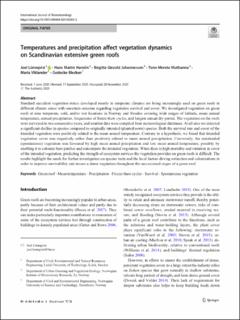| dc.contributor.author | Lönnqvist, Joel | |
| dc.contributor.author | Hanslin, Hans Martin | |
| dc.contributor.author | Johannessen, Birgitte Gisvold | |
| dc.contributor.author | Muthanna, Tone Merete | |
| dc.contributor.author | Viklander, Maria | |
| dc.contributor.author | Blecken, Godecke | |
| dc.date.accessioned | 2021-02-05T09:14:10Z | |
| dc.date.available | 2021-02-05T09:14:10Z | |
| dc.date.created | 2021-01-18T12:02:37Z | |
| dc.date.issued | 2020-12-11 | |
| dc.identifier.citation | International journal of biometeorology. 2020, . | en_US |
| dc.identifier.issn | 0020-7128 | |
| dc.identifier.uri | https://hdl.handle.net/11250/2726339 | |
| dc.description.abstract | Standard succulent vegetation mixes developed mostly in temperate climates are being increasingly used on green roofs in different climate zones with uncertain outcome regarding vegetation survival and cover. We investigated vegetation on green roofs at nine temperate, cold, and/or wet locations in Norway and Sweden covering wide ranges of latitude, mean annual temperature, annual precipitation, frequencies of freeze-thaw cycles, and longest annual dry period. The vegetation on the roofs were surveyed in two consecutive years, and weather data were compiled from meteorological databases. At all sites we detected a significant decline in species compared to originally intended (planted/sown) species. Both the survival rate and cover of the intended vegetation were positively related to the mean annual temperature. Contrary to a hypothesis, we found that intended vegetation cover was negatively rather than positively related to mean annual precipitation. Conversely, the unintended (spontaneous) vegetation was favoured by high mean annual precipitation and low mean annual temperature, possibly by enabling it to colonize bare patches and outcompete the intended vegetation. When there is high mortality and variation in cover of the intended vegetation, predicting the strength of ecosystem services the vegetation provides on green roofs is difficult. The results highlight the needs for further investigation on species traits and the local factors driving extinction and colonizations in order to improve survivability and ensure a dense vegetation throughout the successional stages of a green roof. | en_US |
| dc.language.iso | eng | en_US |
| dc.publisher | Springer Nature | en_US |
| dc.rights | Navngivelse 4.0 Internasjonal | * |
| dc.rights.uri | http://creativecommons.org/licenses/by/4.0/deed.no | * |
| dc.title | Temperatures and precipitation affect vegetation dynamics on Scandinavian extensive green roofs | en_US |
| dc.type | Peer reviewed | en_US |
| dc.type | Journal article | en_US |
| dc.description.version | publishedVersion | en_US |
| dc.rights.holder | © The Author(s) 2020 | en_US |
| dc.source.pagenumber | 13 | en_US |
| dc.source.journal | International journal of biometeorology | en_US |
| dc.identifier.doi | 10.1007/s00484-020-02060-2 | |
| dc.identifier.cristin | 1873104 | |
| cristin.ispublished | true | |
| cristin.fulltext | original | |
| cristin.qualitycode | 1 | |

